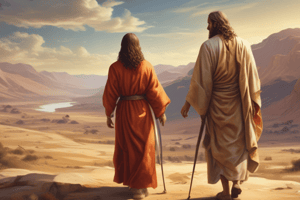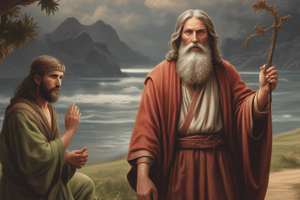Podcast
Questions and Answers
Questions are hidden until you start the quiz
Study Notes
The Reputation of Tax Collectors
- Tax collectors were hated by the local population in the time of Jesus, possibly due to their role as collaborators with the Roman Empire.
- Some scholars argue that tax collectors were corrupt and extorted vast amounts of money from the people, but there is no concrete evidence to support this claim.
- Julius Caesar outlawed the practice of tax farming, which suggests that the law might have been broken during Jesus' time or that the tax collectors were not as corrupt as perceived.
Significant Moments and Mountains in Matthew's Gospel
- Matthew's gospel has a motif of significant moments happening on mountains, unlike Mark's gospel which has boat narratives.
- There are six mountains mentioned in Matthew's gospel, which are:
- The mount of temptation (Matthew 1)
- The sermon on the mount (Matthew 2-5)
- The healing of people on the top of a mountain (Matthew 15)
- The mount of transfiguration (Matthew 17)
- The discussion about the end times on a mountain (Matthew 24)
- The occasion of the disciples meeting the risen Jesus on a mountain (Matthew 28)
Matthew's Gospel: A New Judaism
- Matthew's gospel presents a new form of Judaism, with Jesus as the new Moses and the giver of a new law.
- The gospel has a strong Old Testament feel, with references to Moses and the book of Genesis.
- Jesus is depicted as a rabbi, teaching and communicating the law to his followers.
The Sermon on the Mount
- The sermon on the mount is a collection of the sayings of Jesus, rather than a coherent whole.
- The sermon presents a new and harsher law, with higher expectations from followers.
- Examples of the harsher law include not committing adultery, not looking at a woman with lust, and turning the other cheek.
The Authorship of Matthew's Gospel
- Matthew's gospel was attributed to someone called Matthew, possibly as early as 125 AD.
- The gospel is the only one to mention a tax collector called Matthew, while Luke's gospel refers to a tax collector named Levi.
- The association of Matthew's gospel with a tax collector raises questions about the identity of Matthew and his possible other names.
The Significance of Matthew's Gospel
-
Matthew's gospel has a strong Jewish flavor, with references to the Old Testament and Hebraic phrases.
-
The gospel is structured into five sections, each with a narrative and a discourse, followed by an appendix on Jesus' death and resurrection.
-
The pattern of narrative and discourse is repeated throughout the gospel, with Jesus as the teacher.### Matthew's Use of Old Testament Quotations
-
Matthew quotes from the Old Testament, but the question arises as to which version he uses, the Hebrew Bible or the Greek translation, the Septuagint.
-
In Matthew 21:16, he quotes from Psalm 8:2, using the phrase "out of the mouths of infants and nursing mothers you have prepared praise for yourself", which matches the Septuagint, but differs from the Hebrew text, which reads "you have established might".
-
This indicates that Matthew is using the Septuagint at this point, rather than the Hebrew Old Testament.
Inconsistencies in Quotations
- However, in Matthew 11:29, he quotes from Jeremiah 6:16, using the phrase "you will find rest for your souls", which matches the Hebrew text, but differs from the Septuagint, which reads "you will find purification for your souls".
- This suggests that Matthew is using the Hebrew text at this point, rather than the Septuagint.
- There are also instances where Matthew's quotations do not match either the Septuagint or the Hebrew text, but instead combine elements from multiple sources.
Examples of Mixed Quotations
- In Matthew 27:9-10, he quotes from Jeremiah, but the passage combines elements from Zechariah 11:12-13, Jeremiah 8:1-2, and Jeremiah 32:8-9, suggesting that Matthew may have been quoting from memory rather than a specific textual source.
Implications of Matthew's Quotations
- Matthew's use of various Old Testament versions and mixed quotations raises questions about his sources and methodology.
- It is possible that Matthew knew the Greek and Hebrew texts by heart and drew upon them as needed, sometimes using the Septuagint and sometimes the Hebrew Bible.
- Alternatively, he may have been quoting from memory, combining elements from different sources to create a new whole.
Significance of Matthew's Gospel
- The "mountain" passages in Matthew's Gospel (e.g., the Sermon on the Mount, the Transfiguration) provide a window into the key themes and characterizations of Jesus in Matthew's gospel.
- These passages highlight Jesus as the Son of God, a teacher, a healer, one who talks about the end times, and one who sends disciples on mission.
- Understanding Matthew's use of Old Testament quotations is essential to grasping the significance of his Gospel.
Studying That Suits You
Use AI to generate personalized quizzes and flashcards to suit your learning preferences.




